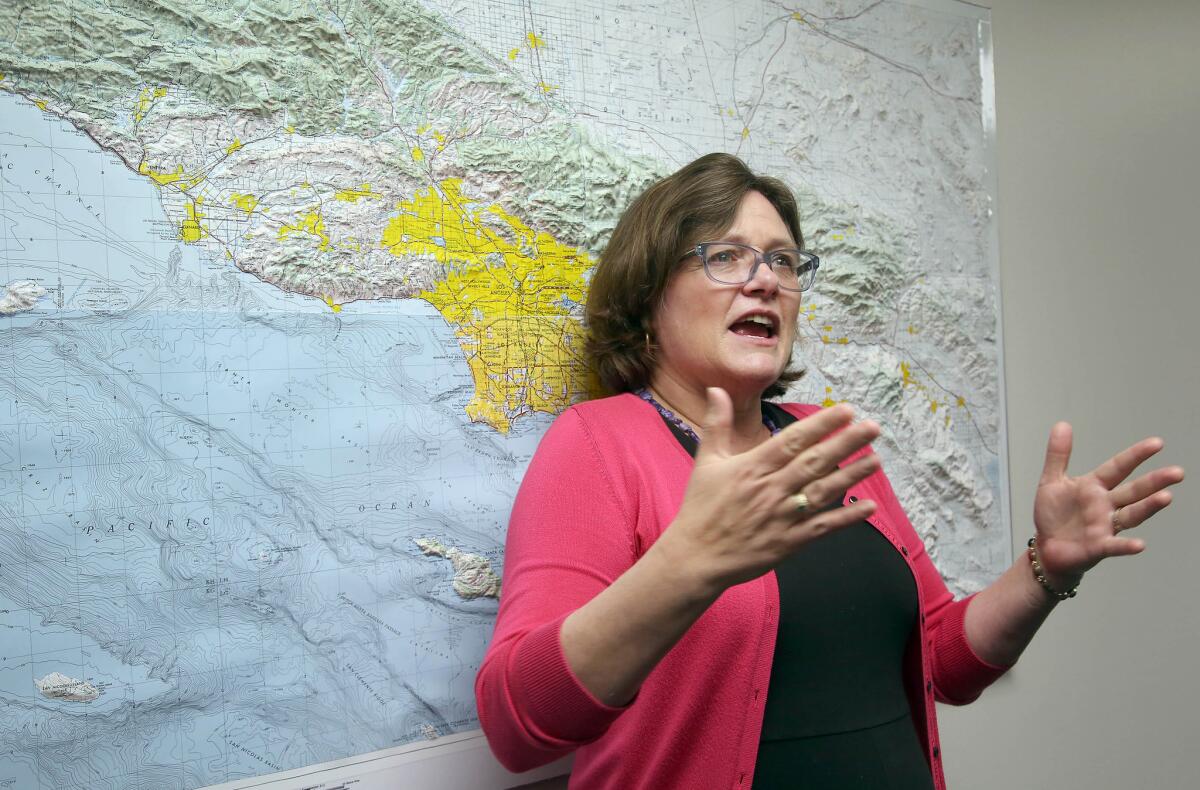Column: Worried about the Big One, L.A.? So’s Lucy Jones, but she’s doing something about it

We’re told to keep enough supplies for three days, a week, two weeks after an earthquake — to last us until help arrives. But that advice doesn’t account for a fractured infrastructure that could leave Los Angeles dry, dark and devastated for months after a big quake. Lucy Jones is the U.S. Geological Survey seismologist seconded by Mayor Eric Garcetti’s office to spend a year creating the city’s first seismic resilience plan. Her grandfather worked for William Mulholland’s DWP, and her great-great and great grandparents are buried in a cemetery on the San Andreas fault. She foresees her future grandkids thriving here, and her recommendations to the city could help all of us do just that.
Much of our earthquake attention is on preventing loss of life. What else should we consider?
I’m trying to get the focus away from [just] life safety, not because it’s not important but because we’ve gotten a lot of that solved. Not very many people die in earthquakes in California anymore. Let’s take a step back and see what the really big need is.
Northridge cost about $40 billion in direct losses, but even if you lost your house, you could have driven five minutes and bought a bottle of water and a hamburger. Forty percent of people then had earthquake insurance, and FEMA checks were written to jurisdictions the day of the earthquake. We got the economic engine going pretty quickly.
After a serious quake, we lose buildings, jobs are gone, there’s no water, no power, nobody can go to work. Only 10% of people now have earthquake insurance; FEMA never writes checks the same day anymore. People will start saying, “I’m out of here.” Once people leave, they tend not to come back. Businesses that have been out of business for six months don’t come back.
Call this the Katrina model. I’m trying to make sure this doesn’t happen in Los Angeles.
You get a lot of your data from a USGS study that modeled the physical, social and economic effects of a 7.8 quake on the San Andreas fault — not the biggest Big One, but a good stand-in for any serious Southern California earthquake on any major fault. You’re concentrating on three areas where the city can make progress: water, buildings and communications. Analyze buildings first.
The building code says you choose how much money to invest [for earthquake resilience] — you just can’t kill people. As long as you can crawl out alive — even if the building has to be torn down — the building code is a success. For the maximum credible earthquake, we try to make sure the building doesn’t collapse.
Still, a big San Andreas earthquake might collapse as much as 1% of buildings built since 1997. Maybe a total of 50% of new buildings will have significant problems. How do we deal with an earthquake that doesn’t kill people but renders half of our buildings unstable?
Let’s say you’re the building owner and you’ve chosen not to retrofit and the building is badly damaged. You lose the value of the building, the tenants lose a place to work, the neighbor tenants lose a place to work because the building department is going to cordon off adjacent buildings. The whole neighborhood loses the use of the street because of debris. If the owner is bankrupt and walks away and that blight stays, everybody’s property values go down. So the consequences of a decision not to retrofit or build to the minimum code has an impact on everybody.
[The 2008 study] figured the business interruption costs over six months are equal to the direct losses — [together totaling] $200 billion.
Why so high?
The scale of a modern urban environment. And all of our lifelines have to cross the San Andreas.
What about water?
Most of our water, 80%, comes from outside L.A. All that imported water has to cross the San Andreas to get to us. A San Andreas earthquake is going to move 10 to 30 feet on one side [of the fault] with respect to the other. The city of L.A.’s aqueduct crosses the San Andreas [in] a 1908 wooden tunnel with a nine-foot diameter. It won’t exist afterward. If all [the water connections to L.A. break], the estimate is up to 18 months to repair them. Eighteen months with only 20% of our water? That’s crisis.
The only way our economy is functioning after a big San Andreas earthquake is to completely re-engineer all those fault crossings so they can’t break. And how about reducing our dependence on imported water, get back to using 50% local water? Half our water goes to landscaping.
Getting water to your house: It would take six months to repair all the [local] water main breaks across Southern California.
There are types of pipe that don’t break in earthquakes. DWP pipes break at the joints. Another type of pipe can be deformed and not break. Tokyo Disney [has] seismic-resistant piping, and in the 2011 earthquake, [it] didn’t break. In the 2011 Christchurch, New Zealand, earthquake, a polyurethane prototype [pipe] 2.5 kilometers long had not one break when [others] were devastated.
Fire estimates double the losses: $50 billion from direct shaking, $50 billion from fire. How do we not make the fire even worse by not having water for the firefighters? In San Francisco they have a backup system of cisterns buried under the city that they put in after 1906, completely separate [from the potable system].
And communications?
That’s the least far along. With water we can look back at previous earthquakes and at what happened. The World Wide Web was released three months after Northridge, [but] telecom has become so important, we can’t wait to see what breaks in the next earthquake before we try to understand it.
So we are now having discussions with telecom companies; we are looking at what happened in Japan [in] 2001. Japan did pretty well; they lost their cellphones for two to three weeks because of loss of electric power. But their towers are built to a higher seismic standard than ours are.
How do you even start to deal with this?
Have I scared you yet?
We’ll have this comprehensive view of all the things that can go wrong. We don’t need to solve all of them; to do that would destroy the economy, and since the point is protecting the economy after the earthquake, there’s no point in destroying it now. We have to be reasonable
If you lose too many buildings and people can’t go to work, that’s going to bring down the economy. But if you [maintain] good Internet, people can work from home and compensate for the lack of buildings.
What will the city do with your work?
The science says these are the consequences. It doesn’t say these are the choices you should make. I’m not trying to be an advocate. I’m trying to help the people who need to make these decisions understand the implications. I see this as a process, a sustainable resilience approach to empowering communities to make these decisions together.
We say: “We’ve got this fault-crossing problem. We could run a pipe over the mountains and it’ll cost X. We can make that pipe unnecessary by cleaning up the San Fernando Valley aquifer; it’s going to cost a lot more than extra pipe.”
I’m a scientist. I think if people understand what’s going on, they can make rational decisions.
It’s not about scaring people into acting.
People are scared enough of earthquakes. We have to get out of the scare. If you’re going to be scared, don’t be scared for your life, be scared for your pocketbook. That’s a very different message.
This interview has been edited and excerpted. patt.morrison@latimes.com Twitter: @pattmlatimes
More to Read
A cure for the common opinion
Get thought-provoking perspectives with our weekly newsletter.
You may occasionally receive promotional content from the Los Angeles Times.







